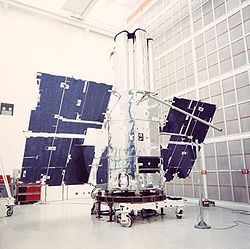Le programme Orbiting Astronomical Observatory (OAO) constitue une famille de quatre satellites artificiels lancés par la NASA entre 1966 et 1972. Ils effectuèrent les premières observations en haute résolution de nombreux objets dans le domaine de l'ultraviolet.
Bien que deux missions OAO échouèrent, le succès des deux autres fit prendre conscience à la communauté astronomique des bénéfices des observatoires spatiaux, et mena quelques années plus tard à la création du télescope spatial Hubble.
OAO-1
Le premier télescope OAO fut lancé avec succès le 8 avril 1966, avec des instruments de détection de rayonnements ultraviolet, X et gamma. Cependant, avant même que les instruments ne puissent être activés, une panne de courant mit fin à la mission au bout de trois jours.
OAO-2
OAO-2 fut lancé le 7 décembre 1968. À son bord, un couplage de 11 télescopes ultraviolet. Le satellite, en service jusqu'en janvier 1973, contribua à de nombreuses découvertes astronomiques.
Cette section est vide,
insuffisamment détaillée ou incomplète.
Votre aide est la bienvenue !
OAO-B
OAO-B était pourvu d'un télescope UV de 96 centimètres de diamètre, et aurait dû fournir les spectres d'objets peu lumineux. Malheureusement, le 3 novembre 1970, jour de son lancement, la coiffe du lanceur ne s'ouvre pas. Le télescope et son lanceur retombent dans l'atmosphère terrestre, ce qui met fin à la mission.
OAO-3 fut lancé le 21 août 1972 et resta en service durant plus de neuf ans, jusqu'en février 1981. Cette mission fut un succès, le plus important du programme OAO. Copernicus retourna des spectres de haute résolution de centaines d'étoiles.
Sources
- Code A.D., Houck T.E., McNall J.F., Bless R.C., Lillie C.F. (1970), Ultraviolet Photometry from the Orbiting Astronomical Observatory. I. Instrumentation and Operation, Astrophysical Journal, v. 161, p.377.
- Rogerson J.B., Spitzer L., Drake J.F., Dressler K., Jenkins E.B., Morton D.C. (1973), Spectrophotometric Results from the Copernicus Satellite. I. Instrumentation and Performance, Astrophysical Journal, v. 181, p. L97.
- NSSDC Master Catalog : OAO-1, OAO-2, OAO-B, OAO-3.
Voir aussi
Articles connexes
Liens externes
v · Programme spatial américain |
| Lanceurs |
Ares (I, V) · Athena · Atlas (I, II, III,V) · Delta (II,III,IV) · Falcon 1,5,9 · Juno I,II · Minotaur · Pegasus · Saturn (Saturn I, IB, V, INT-21) · SLS · Taurus, II · Thor (Agena, Burner) · Scout · Titan (II, III, IIIB, 34D, IV) · Vanguard |
| Missions habitées |
Mercury (1961-1963) · Gemini (1965-1966) · Apollo (1967-1975) · Skylab (1973-1974) · Navette spatiale (1981-2011) · Station spatiale internationale (1998-) · Constellation |
| Exploration du système solaire |
Pioneer¹ (1958-1978) · Ranger¹ (1961-1965) · Mariner¹ ( 1962-1973) · Surveyor¹ (1966-1968) · Viking¹ (1975) · Voyager¹ (1977) · ICE (1978) · Galileo (1989) · Magellan (1989) · Mars Observer (1992) · Near (1996) · Mars Global Surveyor (1996) · Mars Pathfinder (1996) · Cassini-Huygens ²(1997) · Mars Climate Orbiter (1998) · Deep Space (1998) · Stardust (1999) · Mars Polar Lander (2000) · 2001 Mars Odyssey (2001) · CONTOUR (2002) · Mars Exploration Rover¹ (Spirit) (2003) · Deep Impact (2004) · MESSENGER (2004) · Mars Reconnaissance Orbiter (2005) · New Horizons (2006) · Phoenix (2007) · Dawn (2007) · Lunar Reconnaissance Orbiter (2009) · LCROSS (2009) · Mars Science Laboratory (2011) · Juno (2011) · GRAIL (2011) · MAVEN (2013) · LADEE (2013) · Venus In-Situ Explorer (2013) · Solar sentinels¹ (2015) - OSIRIS-REx (2016) - Jupiter Europa Orbiter² (2020) |
| Satellites |
|
| Centres de lancement |
Centre spatial Kennedy · Cap Canaveral · Vandenberg · Wallops Island · Kodiak Launch Complex · Mars · Spaceport America · Ronald Reagan Test Site |
| Établissements de la NASA |
NASA · Lyndon B. Johnson · Langley · Marshall · Dryden Flight Research Center · JPL · Ames · Glenn · Goddard · John C. Stennis · Michoud · White Sands · Deep Space Network |
| Histoire - programmes |
Programme Explorer (1959-) · Programme Lunar Precursor Robotic (en cours) · Programme Flagship (en cours) · Programme Discovery (en cours) · Programme Mars Scout (en cours) · Programme New Frontiers (en cours) · Projet Constellation (en cours) · Programme Earth Observing System (1997-) · Vision for Space Exploration (2004) · NMP (1998-2006) · ESE · Grands observatoires · Innovative Interstellar Explorer · Planetary Grand Tour · Planetary Observer program · SERT · Hitchhiker Program (1984) · NACA (1915-1958) |
| Voir aussi |
X-15 X-33
Les articles rangés dans les catégories NASA , Astronaute américain, Programme spatial américain,
Les autres agences spatiales américaines : DoD, NRO, NGA, NOAA |
| Les dates sont celles du lancement ¹ Programme ou plusieurs satellites ou sondes ²Satellite ou programme international |

